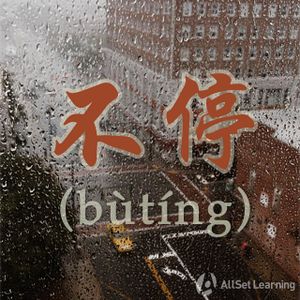Difference between revisions of "Comparing "buduan" and "buting""
m (Text replacement - "lǎopó" to "lǎopo") |
|||
| Line 56: | Line 56: | ||
==Sources and Further Reading== | ==Sources and Further Reading== | ||
| − | |||
| − | |||
[[Category:grammar comparison]] | [[Category:grammar comparison]] | ||
Revision as of 03:19, 4 January 2021
-
Level
-
Similar to
-
Used for
-
Keywords
If something keeps happening and won't stop happening, we say that it is "continuous" or "incessant." In Chinese, the words are 不断 (bùduàn) and 不停 (bùtíng). These two words are usually adverbs in Chinese, but they can sometimes be adjectives too. Their uses are subtly different, so this article will help you distinguish when and where to use them. “不断”意思是在一段时间内是连续但可以有停顿的状态,可以持续很久。 “不停”意思是一直连续不间断,中间没有停止,持续时间不长。
不断
"不断" is usually placed before the verb it modifies, and it often requires the particle "地" to show that it is an adverb.
Subj. + 不断 + 地 + Verb
Examples
- 客户 不断地 改变 主意,怎么 办?The client won't stop changing his ideas. What should I do?
- 过去 的 两 年 里,我们 不断地 在 努力,也 不断地 在 进步。For two years, we continuously pushed ourselves and continuously improved.
- 他们 之间 的 矛盾 一直 不断,关系 不断 恶化。The argument between them is ongoing. The relationship is consistently worsening.
不停
"不停" is a little more versatile and can be placed both before the verb as an adverb, or after the verb as something that is somewhat like a complement. Either way, it means the same thing.
Subj. + 不停 + 地 + Verb
Examples
- 我 今天 很 困,不 停 地 打 哈欠。I'm so tired today. I can't stop yawning.
- 感冒 了,喉咙 痛,还 不 停 地 流 鼻涕。I got a cold. My throat hurts and my nose runs constantly.
- 吃饭 的 时候 他 一 句 话 也 不 说,不 停 地 吃。When he's eating, he doesn't say anything. He doesn't stop eating.
When "不停" comes after the verb, it behaves somewhat strangely and takes "个" before it in order to become grammatical, like so:
Subj. + Verb + 个 + 不停
Examples
- 孩子 哭 个 不停,是 不 是 发烧 了?The child is crying constantly. Does he have a fever?
- 你 一直 说 个 不停,太 吵 了,不 要 再 说 了。You've been talking non-stop. It's too noisy.
- 今天 电话 响 个 不停,烦 死 了。The phone is ringing off the hook today. It's so annoying.
- 一天到晚 老婆 唠叨 个 不停,你 受得了 吗?All day long, the wife doesn't stop nagging. Would you be able to stand it?



